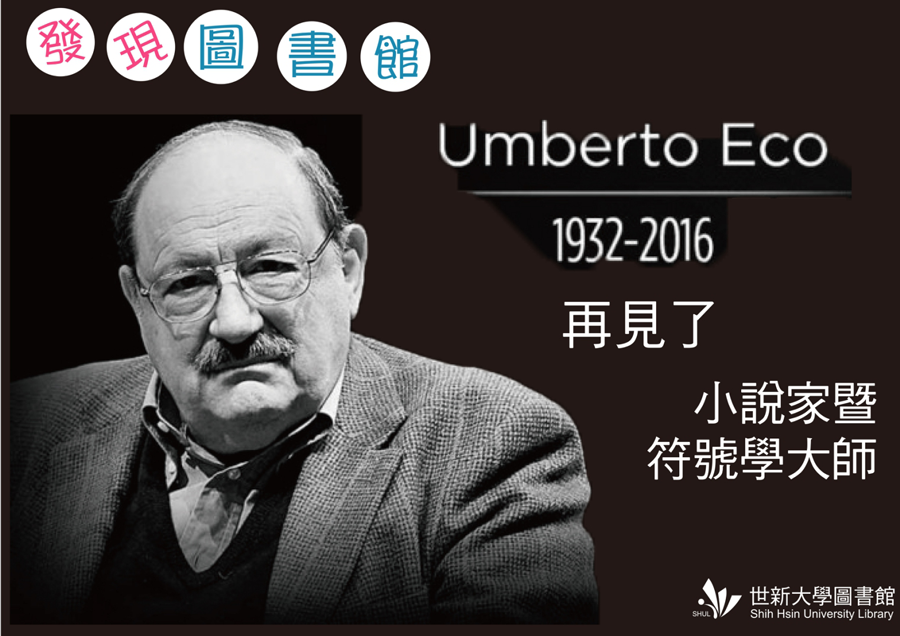| |
書 名 |
作 者 |
出版年 |
書的位置 |
簡 介 |
| 1 |
玫瑰的名字 / |
安伯托.艾可 |
2014 |
877.57 83652 v.2 |
本書為艾可的第一部小說,也是最膾炙人口的經典之作,中文版出版多年,一直有穩定的銷售,本次為方便讀者閱讀,特別重新以大字排版,並更換新封面,希望給讀者耳目一新的感覺。 |
| 2 |
布拉格墓園 / |
艾可,安伯托 |
2013 |
877.57 885-6 |
繼《玫瑰的名字》探討理性與信仰,《傅科擺》辯證真實與虛構後,暌違六年,當代符號語言學大師艾可結合這兩部代表作。 |
| 3 |
植物的記憶與藏書樂 / |
艾可,安博托 |
2012 |
877.6 885-3 |
艾可大師橫跨歷史、文學、美學與科學的多元向度,暢談奇書軼事,關於書的意義與價值,關於閱讀的必要,關於愛書人無可自拔的執迷。而因著這些書的記憶,我們不厭其煩地蒐書、讀書、愛書、藏書,並從中獲得了無可取代的樂趣! |
| 4 |
倒退的年代 : 跟著大師艾可看世界 / |
艾可,安伯托 |
2011 |
877.6 885-4 |
金融風暴、油價飆漲、政權轉移、宗教紛爭……在全球化和區域整合的浪潮下,世界其他角落的風吹草動其實都將會影響我們的生活!只有站在艾可大師的肩膀上,透過他的宏觀視野解讀分析,我們才得以理解這些事件背後的歷史連結和前因後果,並看清楚這個時代所發出的警訊! |
| 5 |
別想擺脫書 / |
艾可,安博托 |
2010 |
011.2 885 |
多年來,艾可深深地思索自己和書本的關係,並發覺書的種種影響:書籍紙張單純的香氣滋養,竟然能讓人定心安神。 |
| 6 |
羅安娜女王的神秘火焰 / |
艾可,安博托 |
2009 |
877.5 7 885-5 |
艾可以過人的才華、淵博的智識,透過主角對生命過往的追溯與探尋,帶領讀者一起穿越時空,暢遊文學、音樂、藝術與歷史,不但重現了大師的成長歷程和內心世界,更是大師對甘美與苦澀兼具的青春歲月的禮讚! |
| 7 |
New essays on Umberto Eco / |
Bondanella, Peter E., 1943- |
2009 |
853.914 Ne 2009 |
There is a wealth of critical commentary on Umberto Eco in scholarly books and articles; this collection provides thought-provoking insights into topics that have attracted a great deal of attention in the past without repeating many of the arguments found in earlier publications on Eco. |
| 8 |
醜的歷史 |
艾可,安博托 |
2008 |
180.94 885 |
繼讓全球驚艷的《美的歷史》之後,博學大師安柏托.艾可寫出「醜」,而且他親自保證,一定比「美」更精采。 |
| 9 |
美的歷史 / |
艾可,安博托 |
2006 |
180.7 885 |
作者以獨到見解,將美於時代洪流中抽絲剝繭,對美的發展歷程做廣博精闢的說明,廣及文學、藝術等各方面都概括統合,呈現方式具獨特的質感、美感,儼然一部不可多得的收藏寶典。 |
| 10 |
开放的作品 / |
艾可,安博托 |
2005 |
812.1 885 |
《開放的作品》至今仍然是就語言技術和20世紀先鋒派藝術的思想意識作用進行的討論所依據的坐標,這里所說的先鋒派藝術既包括“歷史的”先鋒派,也包括“新先鋒派”,對這種“新先鋒派”既做了最具挑戰性的理論總結,也進行了最詳盡的批評。 |
| 11 |
Umberto Eco / |
Gane, Mike. |
2005 |
853.914 Um 2005 v.1 |
Umberto Eco is arguably best known for his novel The Name of the Rose yet there is much more to him than simply being an exemplary novelist. Semiotician, literary and media critic, philosopher and historian, Umberto Eco is one of the greatest and most original thinkers working today. |
| 12 |
The name of the rose / |
Eco, Umberto. |
2004 |
853.914 Ec 2004 |
The year is 1327. Franciscans in a wealthy Italian abbey are suspected of heresy, and Brother William of Baskerville arrives to investigate. |
| 13 |
Kant and the platypus |
Eco, Umberto. |
2000 |
302.2 Ec 2000 |
The book develops some aspects of Eco’s A Theory of Semiotics which came out in 1976. |
| 14 |
Umberto Eco : philosophy, semiotics, and the work of fiction / |
Caesar, Michael. |
1999 |
853.914 Ca3 1999 |
This book provides a comprehensive introduction to the work and thought of Umberto Eco – one of the most important writers in Europe today |
| 15 |
昨日之島 / |
艾可,安博托 |
1998 |
877.57 885-3 |
開始於一次發生在一六四三年的船難,唯一的倖存者羅貝托在追尋換日線祕密的同時,面對的卻是一場永遠無法登岸的冒險……國際最富盛譽的記號語言學大師艾可以幽默、懸疑、機智的文字手法,再次帶領我們經歷了一次探索浩瀚知識真相的生命之旅! |
| 16 |
Umberto Eco and the open text : semiotics, fiction, popular culture / |
Bondanella, Peter E., |
1997 |
853.914 Bo 1997 |
In clear and accessible language, he traces the development of Eco’s interests, from medieval aesthetics to semiotics to popular culture, and shows how Eco’s own fiction grows out of his literary and cultural theories. |
| 17 |
The search for the perfect language / |
Eco,Umberto. |
1995 |
401.3 Ec 1995 |
This is an investigation into the history of that idea and of its profound influence on European thought, culture and history. |
| 18 |
The limits of interpretation / |
Eco, Umberto. |
1994 |
801.95 Ec-2 1994 |
If anyone can make [semiotics] clear, it’s Professor Eco’s theme deserves respect; language should be used to communicate more easily without literary border guards. |
| 19 |
Six walks in the fictional woods / |
Eco,Umberto. |
1994 |
808.3 Ec 1994 |
This is a non-fiction book by Umberto Eco. Originally delivered at Harvard for the Charles Eliot Norton Lectures in 1992 and 1993, the six lectures were published in the fall of 1994. |
| 20 |
傅科擺 / |
艾可,安博托 |
1992 |
877.57 885-2 |
三個米蘭出版社的編輯,偶然間得到一則類似密碼的訊息,是有關於幾世紀前聖堂武士的一項秘密計畫。三個人平常受夠了各種怪力亂神的編務工作,一時興起,突發奇想,便決定自己來編造這個超級『計畫』。 |
| 21 |
Interpretation and overinterpretation / |
Eco,Umberto |
1992 |
801.95 Ec 1992 |
This volume consists of three lectures by Umberto Eco, some responses from scholars who were debating Eco when he gave the lectures, and a final reply from Eco |
| 22 |
The open work / |
Eco, Umberto. |
1989 |
111.85 Ec 1989 |
The Open Work remains significant for its powerful concept of “openness”–the artist’s decision to leave arrangements of some constituents of a work to the public or to chance–and for its striking anticipation of two major themes of contemporary literary theory: the element of multiplicity and plurality in art, and the insistence on literary response as an interactive process between reader and text. |
| 23 |
The aesthetics of Thomas Aquinas / |
Eco, Umberto. |
1988 |
111.850924 Ec 1988 |
Umberto Eco discloses for the first time to English-speaking readers the unsuspected richness, breadth, complexity, and originality of the aesthetic theories advanced by the influential medieval thinker Thomas Aquinas, heretofore known principally as a scholastic theologian. |
| 24 |
Semiotics and the philosophy of language / |
Eco, Umberto. |
1986 |
401.41 Ec 1986 |
Eco wittily and enchantingly develops themes often touched on in his previous works, but he delves deeper into their complex nature… this collection can be read with pleasure by those unversed in semiotic theory. |
| 25 |
The role of the reader : explorations in the semiotics of texts / |
Eco, Umberto. |
1979 |
801.95 Ec-3 1979 |
He investigates the contributions of contemporary semantics to the study of narrative, and connects the modalities of textual interpretation with the problem of possible worlds. |

